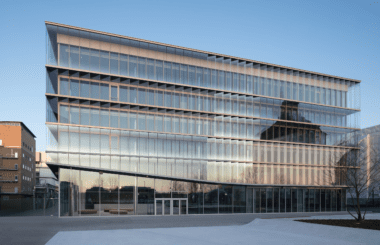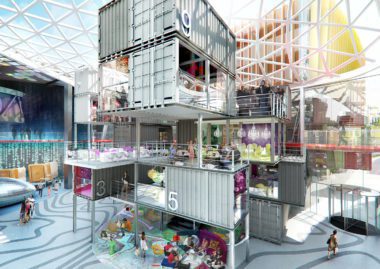Over the last months we (at theLivingCore) have put ourselves in an observer position tracing and juggling predictions about what a post-corona office may look like, respectively if we will need offices at all in the future.
Predictions made by trend experts at the beginning of the pandemic gave hope to many people: “we all will be fine and happy by October”. Now, it is time to elaborate more seriously on the impact of COVID-19 on office spaces.
”People have been predicting the end of the office since the invention of Wi-Fi and laptops. Today, lots of people are suggesting the office will go away as companies fully embrace work from home as a way to give people greater flexibility. During the crisis, anyone who could work from home did and, for a while, many people thought it worked pretty well. But after months of living on video, the novelty has worn off. The vast majority of us — 88-90% depending on the study — want to work in an office again.”
Steelcase Research
Exploring new approaches and solutions
First, and of immediate importance to companies right now, the question of how to make offices in times of a pandemic safe and productive needs to be solved quickly (see also “Reimagining the office and work life after COVID-19” from McKinsey). Furniture provider Bene is offering shielding devices to physically divide work spaces. Cushman & Wakefield proposed a 6-feet office, a concept that has been widely critiqued for creating rather soulless spaces. Gensler created a physical distancing tool that uses generative algorithms to plan office occupancy thus reconfiguring workspaces. Kerstin Sailer introduced configurational thinking as a means to take advantage of various layout settings of buildings and mapping them onto traffic movements of workers in offices. Many more solutions are explored and tried out right now.
In most cases, these solutions focus on health aspects triggered by COVID-19: physical distancing, reducing transmission risks, dealing with air flows, etc. They are worth considering, however, primarily as features and means, but not as final goals. Or, to put it differently: we are not convinced that redesigning entire offices as ”post-corona-offices”, or that refurbishing them into 6-feet rather ”sterile” work environments is a purpose in itself.
So, what could be guiding principles or desirable goals, in the quest to (re-)imagine and create offices that are future-ready? Based on our practical work, theoretical considerations, as well as our observations, we suggest to introduce two principles that we consider paramount in the context of future offices: (i) clarity on the purpose of your office and (ii) the importance of face-to-face time (enabled by appropriate spaces) for creating and sustaining social coherence.
(Office) space as an enabler for realizing strategy
Shortly after the outbreak of the corona pandemic, the real estate developer HB Reavis started the innovation project ”office 2030“. The company approached us and we had very insightful conversations, highlighting the importance for organizations to understand why they should invest in offices at all. This might seem trivial, but as so often, the obvious and taken-for-granted assumptions and beliefs are the most interesting to question. As we observe in many cases, organizations are, for most part, “housing” people in their offices. Regardless of employees´ particular type of work or tasks, they commute to the office every day, sit in front of a screen most of the time, and travel home in the afternoon / evening. So, even before this pandemic, employees and managers saw this model outdated, however, not much has changed.
COVID-19 acts now as an accelerator to rethink why employees should come into the office: because of alignment, because of innovation activities, or is the reason communication? There is no single answer here. Rather, the purpose of an office needs to be worked out in a process that is future-oriented and guided by this framing question: what will be our organizational core processes supporting our purpose in the future and what kind of enabling (physical) spaces do these processes require? Companies with a clear purpose giving them orientation have a long-term advantage, since many decisions these companies need to make are coherent and aligned. In such a context, office space becomes an enabler for realizing the future (strategy) of an organization.
“Social” is built on trust which in turn affords presence and physical space
Imagine a scenario in which we would have to work together virtually with colleagues who we have never met yet. At best, it would consume an awful amount of time to get to know and (literally) understand each other, to work productively, and to trust each other. Currently, interesting studies are being published addressing the phenomenon of “zoom induced social distance”:
“´It’s almost like you’re emoting more because you’re just a little box on a screen,´ Eichler-Levine says. ´I’m just so tired.´ So many people are reporting similar experiences that it’s earned its own slang term, Zoom fatigue, though this exhaustion also applies if you’re using Google Hangouts, Skype, FaceTime, or any other video-calling interface. The unprecedented explosion of their use in response to the pandemic has launched an unofficial social experiment, showing at a population scale what’s always been true: virtual interactions can be extremely hard on the brain.”
Julia Sklar in National Geographic
The reason for the mostly (very) positive feedback of remote and virtual working during COVID-19 stems from the built-up social capital in pre-corona face-2-face time. Put differently:
“It’s clear that social connection builds trust and strong bonds. But our ability to adapt to working remotely is reliant upon the relationships built over time through the spontaneous interactions and relaxed conversations that happen in person – in a conducive environment. The informal, shared spaces – or ancillary spaces – where we socialized, collaborated, focused and rejuvenated, enhanced our work experience before COVID-19 sent us all home.”
Quote from Steelcase´s excellent article “Why do we miss the office?”
Based on the quotation above, we all have to consider the following important questions: how long can our social capital be kept alive so that our social coherence does not collaps and our virtual interactions do not become unproductive? How much physical presence time do we need to build up, or sustain existing social coherence – is this about quantity or quality? What kind of practices and routines enable social coherence? Etc.
Answering these questions circles back to the purpose of an office. As we have seen in daily practice, investing time and effort in elaborating on such strategic issues pays off several times as it speeds up decisions and investments, creates orientation and alignment for co-workers, and develops the organization in a coherent and future-ready direction.
Subscribe to Our Newsletter
Keep your innovative edge with more stories like this and additional reading tips, muses, and project updates.
Image: Sarah Dorweiler at Unsplash


